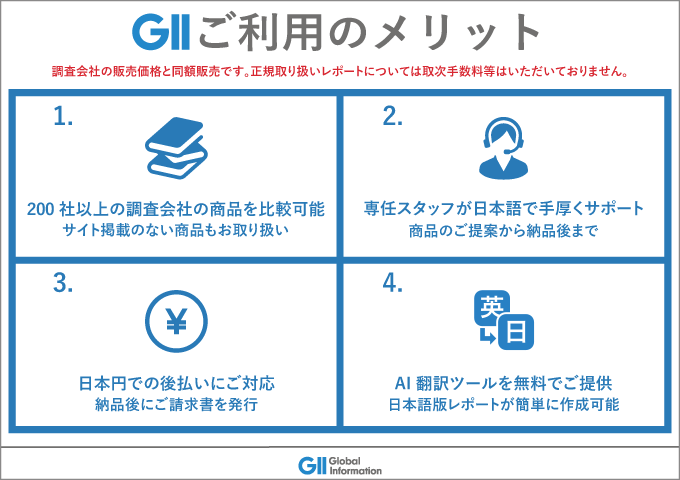|
|
市場調査レポート
商品コード
1243965
全身性エリテマトーデスおよびループス腎炎の疫学分析と予測:2021年~2031年Systemic Lupus Erythematosus and Lupus Nephritis Epidemiology Analysis and Forecast, 2021-2031 |
||||||
|
● お客様のご希望に応じて、既存データの加工や未掲載情報(例:国別セグメント)の追加などの対応が可能です。 詳細はお問い合わせください。 |
|||||||
| 全身性エリテマトーデスおよびループス腎炎の疫学分析と予測:2021年~2031年 |
|
出版日: 2023年02月28日
発行: GlobalData
ページ情報: 英文 59 Pages
納期: 即納可能
|
- 全表示
- 概要
- 図表
- 目次
当レポートでは、主要7市場(米国、フランス、ドイツ、イタリア、スペイン、英国、日本)における全身性エリテマトーデスおよびループス腎炎の危険因子、併存疾患、世界および過去の疫学動向について調査し、疫学動向、10年間の疫学予測をまとめています。
目次
第1章 全身性エリテマトーデス(SLE)およびループス腎炎(LN):エグゼクティブサマリー
第2章 疫学
- 疾患の背景
- 危険因子と合併症
- 世界的および歴史的動向
- 主要7ヶ国の予測調査手法
- SLEおよびLNの疫学的予測(2021年~2031年)
- SLEの診断済み症例
- SLEの年齢別診断済み発症例
- SLEの性別診断済み発症例
- SLEの診断済み罹患症例
- SLEの年齢別診断済み罹患症例
- SLEの性別診断済み発症例
- SLEの重症度別診断済み罹患症例
- LNの診断済み発症例
- LNの年齢別診断済み発症例
- LNの性別診断済み発症例
- LNの診断済み罹患症例
- LNのISN/RPS分類に基づく重症度別診断済み罹患症例
- LNの治療別診断済み罹患症例
- 議論
- 疫学的予測の洞察
- COVID-19の影響
- 分析の限界
- 分析の強み
第3章 付録
- 参考文献
- 著者について
- お問い合わせ
List of Tables
List of Tables
- Table 1: Summary of newly added data types
- Table 2: Summary of updated data types
- Table 3: Risk factors and comorbidities for SLE
- Table 4: 7MM, diagnosed prevalent cases of LN by severity based on ISN/RPS classification, N, both sexes, all ages, 2021
List of Figures
List of Figures
- Figure 1: 7MM, diagnosed incident cases of SLE, both sexes, N, all ages, 2021 and 2031
- Figure 2: 7MM, diagnosed prevalent cases of SLE, both sexes, N, all ages, 2021 and 2031
- Figure 3: 7MM, diagnosed incident cases of LN, both sexes, N, all ages, 2021 and 2031
- Figure 4: 7MM, diagnosed prevalent cases of LN, both sexes, N, all ages, 2021 and 2031
- Figure 5: 7MM, diagnosed incidence of SLE (cases per 100,000 population), men and women, all ages, 2021
- Figure 6: 7MM, diagnosed prevalence of SLE (%), men and women, all ages, 2021
- Figure 7: 7MM, diagnosed incidence of LN (cases per 100,000 population), men and women, all ages, 2021
- Figure 8: 7MM, sources used and not used to forecast the diagnosed incident cases of SLE
- Figure 9: 7MM, sources used and not used to forecast the diagnosed prevalent cases of SLE
- Figure 10: 7MM, sources used to forecast the diagnosed prevalent cases of SLE by severity
- Figure 11: 7MM, sources used to forecast the diagnosed incident cases of LN
- Figure 12: 7MM, sources used to forecast the diagnosed prevalent cases of LN
- Figure 13: 7MM, sources used to forecast the diagnosed prevalent cases of LN by severity based on ISN/RPS classification
- Figure 14: 7MM, sources used to forecast the diagnosed prevalent cases of LN who received treatment
- Figure 15: 7MM, diagnosed incident cases of SLE, N, both sexes, all ages, 2021
- Figure 16: 7MM, diagnosed incident cases of SLE by age, N, both sexes, 2021
- Figure 17: 7MM, diagnosed incident cases of SLE by sex, N, all ages, 2021
- Figure 18: 7MM, diagnosed prevalent cases of SLE, N, both sexes, all ages, 2021
- Figure 19: 7MM, diagnosed prevalent cases of SLE by age, N, both sexes, 2021
- Figure 20: 7MM, diagnosed prevalent cases of SLE by sex, N, all ages, 2021
- Figure 21: 7MM, diagnosed prevalent cases of SLE by severity, N, both sexes, all ages, 2021
- Figure 22: 7MM, diagnosed incident cases of LN, N, both sexes, all ages, 2021
- Figure 23: 7MM, diagnosed incident cases of LN by age, N, both sexes, 2021
- Figure 24: 7MM, diagnosed incident cases of LN by sex, N, all ages, 2021
- Figure 25: 7MM, diagnosed prevalent cases of LN, N, both sexes, all ages, 2021
- Figure 26: 7MM, diagnosed prevalent cases of LN by treatment received, N, both sexes, all ages, 2021
Systemic lupus erythematosus (SLE) is a complex autoimmune disease with a chronic relapsing and remitting course, having variable manifestations ranging from mild to life-threatening illness (Tsokos, 2011). In SLE, the immune system attacks its own tissues, causing widespread inflammation and tissue damage in the affected organs (Centers for Disease Control and Prevention, 2022). SLE is also referred to as lupus interchangeably by physicians (Askanase, Shum and Mitnick, 2012; Giles, 2021). The disease typically affects several different organ systems of the body, which include the kidneys, skin, joints, heart, nervous system, lungs, and blood vessels (Justiz Vaillant, Goyal and Varacallo, 2022). SLE patients experience a variety of symptoms that include fatigue, skin rashes including sun sensitivity rashes such as a malar or "butterfly" rash, fever, and pain or swelling in the joints (Centers for Disease Control and Prevention, 2022). The disease condition causes symptoms that may get worse over time and then improve. According to the Lupus Foundation of America, the times when symptoms get worse are called flares, and the periods when they improve or go away are known as remissions (Lupus Foundation of America, 2020).
Among SLE patients, one-third to almost half have renal manifestation, referred to as lupus nephritis (LN) (Lee et al., 2010). LN is one of the most serious complications of SLE (Lupus Foundation of America, 2021a). LN occurs when lupus autoantibodies affect structures in the kidneys that filter out waste. This causes kidney inflammation and may lead to blood in the urine, protein in the urine, high blood pressure, weight gain, swollen ankles, impaired kidney function, or even kidney failure (Lee et al., 2010; Mayo Clinic, 2022b).
In the 7MM, diagnosed incident cases of SLE are expected to increase from 36,601 cases in 2021 to 37,303 cases in 2031, at an annual growth rate (AGR) of 0.19%. In 2031, the US will have the highest number of diagnosed incident cases of SLE in the 7MM, with 17,994 cases, whereas Spain will have the fewest diagnosed incident cases of SLE with 635 cases. Although the overall trend shows an increase in the diagnosed incident cases of SLE across the 7MM, GlobalData epidemiologists expect that there will be several markets (Germany, Italy, Spain, and Japan) where the number of diagnosed incident cases of SLE will decrease from 2021-31. Japan will have the greatest decrease in diagnosed incident cases of SLE, from 4,668 cases in 2021 to 4,409 cases in 2031, with a negative AGR of 0.55%. In the 7MM, the diagnosed prevalent cases of SLE are expected to increase from 551,826 cases in 2021 to 579,991 cases in 2031, at an AGR of 0.51%. In 2031, the US will have the highest number of diagnosed prevalent cases of SLE in the 7MM, with 258,075 cases, whereas Italy will have the fewest diagnosed prevalent cases of SLE with 26,767 cases.
In the 7MM, diagnosed incident cases of LN are expected to increase from 5,065 cases in 2021 to 5,141 cases in 2031, at an AGR of 0.15%. In 2031, the US will have the highest number of diagnosed incident cases of LN in the 7MM, with 3,564 cases, whereas Spain will have the fewest diagnosed incident cases of LN with 62 cases. Although the overall trend shows an increase in the diagnosed incident cases of LN across the 7MM, GlobalData epidemiologists expect that there will be several markets (France, Germany, Italy, Spain, and Japan) where the number of diagnosed incident cases of LN will decrease from 2021-31. Japan will have the greatest decrease in diagnosed incident cases of LN, from 778 cases in 2021 to 693 cases in 2031, with a negative AGR of 1.09%. In the 7MM, the diagnosed prevalent cases of LN are expected to increase from 161,216 cases in 2021 to 166,019 cases in 2031, at an AGR of 0.30%. In 2031, the US will have the highest number of diagnosed prevalent cases of LN in the 7MM, with 75,715 cases, whereas Italy will have the fewest diagnosed prevalent cases of LN with 7,849 cases. GlobalData epidemiologists attribute the increase in the diagnosed incident cases and diagnosed prevalent cases of SLE and LN to changes in the diagnosed incidence and diagnosed prevalence rates, and population dynamics in each market.
Scope
- This report provides an overview of the risk factors, comorbidities, and the global and historical epidemiological trends for SLE and LN in the seven major markets (7MM: US, France, Germany, Italy, Spain, UK, and Japan). The report includes a 10-year epidemiology forecast for the diagnosed incident cases and diagnosed prevalent cases of both SLE and LN. The diagnosed incident cases of SLE and LN, and the diagnosed prevalent cases of SLE, are segmented by age (in five-year age-groups) and sex. The report also includes the diagnosed prevalent cases of SLE by severity (uncomplicated SLE [mild] and complicated SLE [moderate/severe]], and the diagnosed prevalent cases of LN segmented by severity based on the 2003 International Society of Nephrology (ISN)/Renal Pathology Society (RPS) classification (class I, class II, class III, class IV, class V, and class VI). Additionally, diagnosed prevalent cases of LN are segmented by treatment received. This epidemiology forecast for SLE and LN is supported by data obtained from peer-reviewed articles and population-based studies. The forecast methodology was kept consistent across the 7MM to allow for a meaningful comparison of the forecast diagnosed incident cases and prevalent cases and diagnosed prevalent cases of SLE and LN across these markets.
Reasons to Buy
The SLE and LN epidemiology series will allow you to -
- Develop business strategies by understanding the trends shaping and driving the global SLE and LN market.
- Quantify patient populations in the global SLE and LN market to improve product design, pricing, and launch plans.
- Organize sales and marketing efforts by identifying the age groups that present the best opportunities for SLE and LN therapeutics in each of the markets covered.
Table of Contents
Table of Contents
1 Systemic Lupus Erythematosus and Lupus Nephritis: Executive Summary
- 1.1 Catalyst
- 1.2 Related reports
- 1.3 Upcoming reports
2 Epidemiology
- 2.1 Disease background
- 2.2 Risk factors and comorbidities
- 2.3 Global and historical trends
- 2.4 7MM forecast methodology
- 2.4.1 Sources
- 2.4.2 Forecast assumptions and methods
- 2.4.3 Diagnosed incident cases of SLE
- 2.4.4 Diagnosed prevalent cases of SLE
- 2.4.5 Diagnosed prevalent cases of SLE by severity
- 2.4.6 Diagnosed incident cases of LN
- 2.4.7 Diagnosed prevalent cases of LN
- 2.4.8 Diagnosed prevalent cases of LN by severity (ISN/RPS classification)
- 2.4.9 Diagnosed prevalent cases of LN by treatment received
- 2.5 Epidemiological forecast for SLE and LN (2021-31)
- 2.5.1 Diagnosed incident cases of SLE
- 2.5.2 Age-specific diagnosed incident cases of SLE
- 2.5.3 Sex-specific diagnosed incident cases of SLE
- 2.5.4 Diagnosed prevalent cases of SLE
- 2.5.5 Age-specific diagnosed prevalent cases of SLE
- 2.5.6 Sex-specific diagnosed prevalent cases of SLE
- 2.5.7 Diagnosed prevalent cases of SLE by severity
- 2.5.8 Diagnosed incident cases of LN
- 2.5.9 Age-specific diagnosed incident cases of LN
- 2.5.10 Sex-specific diagnosed incident cases of LN
- 2.5.11 Diagnosed prevalent cases of LN
- 2.5.12 Diagnosed prevalent cases of LN by severity based on ISN/RPS classification
- 2.5.13 Diagnosed prevalent cases of LN by treatment received
- 2.6 Discussion
- 2.6.1 Epidemiological forecast insight
- 2.6.2 COVID-19 impact
- 2.6.3 Limitations of the analysis
- 2.6.4 Strengths of the analysis
3 Appendix
- 3.1 Bibliography
- 3.2 About the authors
- 3.2.1 Epidemiologist
- 3.2.2 Reviewers
- 3.2.3 Global Director of Therapy Analysis and Epidemiology
- 3.2.4 Global Head and EVP of Healthcare Operations and Strategy
- Contact Us




